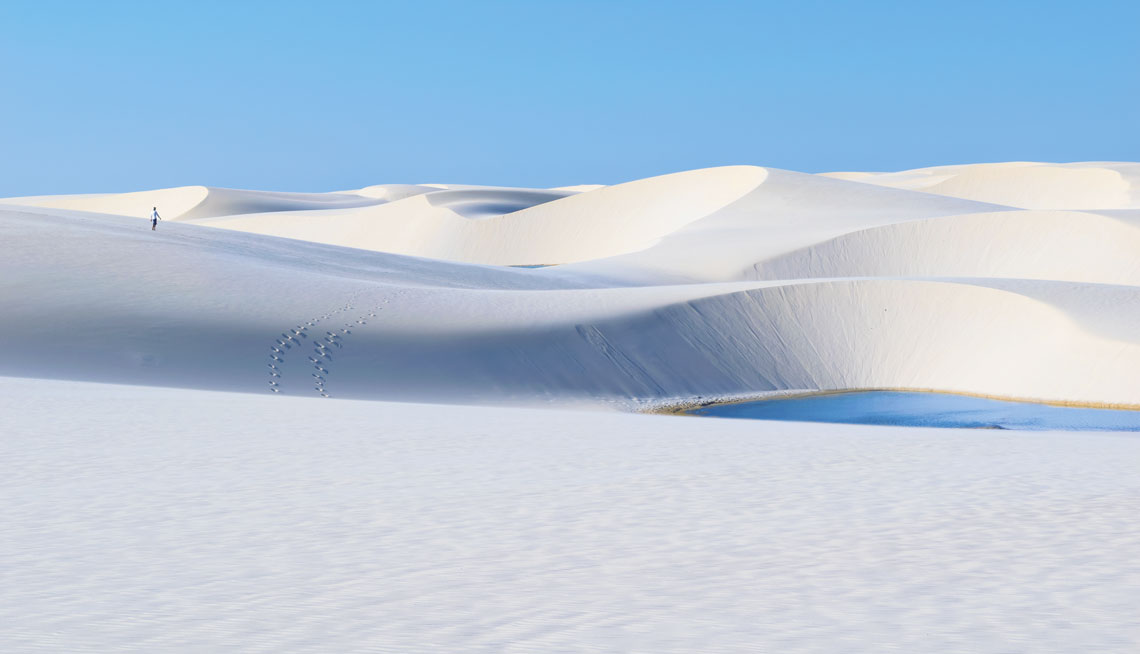
Léo Ramos Chaves / Pesquisa FapespFor Herrmann, the song of the dunes is one of the most fascinating characteristics of migratory sand moundsLéo Ramos Chaves / Pesquisa Fapesp
It was not the stunning beaches of the sun-kissed Ceará coastline that led German physicist and statistician Hans Jürgen Herrmann, 70, to make Fortaleza his home for eight months a year—it was the opportunity to be close to one of his most intriguing objects of study: Brazilian coastal dunes, most notably in Jericoacoara, Ceará State, and Lençóis Maranhenses, a national park in the state of Maranhão with a land area similar to that of São Paulo City.
For almost 3 decades, this specialist in complex systems has dedicated his work, among other theoretical physics areas, to understanding the formation and movement of these sand mounds molded by the wind. Based on real parameters measured in the field, he attempts to reproduce the origin and evolution of different types of dunes through computational modeling.
“Technically, dunes are aerodynamic instabilities of a granular surface. Their form depends on the amount of sand available and the wind direction,” says the physicist, born in Cuba, raised in Colombia, and graduated in Germany. “They are one of those daily phenomena we don’t understand very well.”
A researcher at the Federal University of Ceará (UFC) and the Hyatt School of Industrial Chemistry and Physics (ESPCI) in Paris, Herrmann visited FAPESP headquarters in São Paulo in early March this year, where he ran a conference on the study area that led him to switch from Europe to Brazil.
In this interview, given after his presentation, he talks of his work and why he based himself in Ceará’s capital. He found there a good infrastructure to deploy to the field and get his feet in the sand when he needed to, and to conduct his calculations and modeling with the help of colleagues and students from the university, he says.
Why would a physicist come to study dunes?
I work with statistical physics and its applications across different areas, such as engineering and social sciences. I have studied the brain, epidemics, and opinion diffusion, for example. These areas are different on the surface, but they use similar mathematics. They are collective events, in which many agents together create new phenomena, which are always competing against disorder. The interaction between these agents or particles is a complex network, which can demonstrate different degrees of freedom. Therefore, these phenomena, such as thermodynamic phase transitions, can be studied as applications of the same math. Dunes are one of the most interesting complex phenomena.
The dunes of Jericoacoara can move 8 meters per year due to the strong winds on the peninsula
What led you specifically to study dunes in Brazil?
I first visited Brazil well before I started researching dunes. In 1986 I met Constantino Tsallis, of the Brazilian Center for Physics Research [CBPF], at a conference in Montreal, Canada, and he invited me to visit. I came, and I liked it so much that I told him I wanted to come back and stay longer. He got me a scholarship from the USA’s Guggenheim Foundation, and I spent a year in Rio de Janeiro with Constantino, between 1987 and 1988. We did a study into the origin of life. I only began my studies into dunes almost 10 years later.
How did this interest come about?
When I was a laboratory director at ESPCI in Paris in the 1990s, I worked with granular materials and received some Brazilian postdoctoral academics. With them and students of other nationalities, we organized expeditions to dune fields in places such as Morocco and Ceará. Dunes are aerodynamic instabilities of a granular surface. Their sand is brought by the wind from the sea. In 1996 I made contact with a physics professor from UFC who had been my postdoctoral student, and together we visited the dunes of Jericoacoara, which seemed very interesting. We worked with UFC’s Ocean Science Institute (LABOMAR), specialized in dune management. I really liked UFC. Twenty years ago, I bought an apartment in Fortaleza and now I live there when I spend September to April in Brazil. I travel overseas for the rest of the year. I no longer give classes, but I have affiliations. In Paris, the laboratory where I was director for years still keeps an office for me, but I do not tutor students in Europe—only in Ceará.
Is there anything different about the dunes of Ceará?
There are dunes all over the world. In Brazil alone, we have coastal dunes along an extension of more than 3,000 kilometers [km], from the southern state of Rio Grande do Sul to Pará State in the North. For the most part these are fossilized parabolic dunes, flatter, ancient formations, practically covered by the actions of time. But there are also places where strong winds form migratory dunes, such as in Jericoacoara, which has large mobile dunes. It’s easier to take measurements of larger dunes, which are stable and symmetrical. They present fewer fluctuations and provide data with a narrower margin of error than smaller ones. Jericoacoara has the world’s largest migratory barchan [dune in the form of a crescent moon] some 2 km in width, moving 8 meters [m] per year in the strong winds of the peninsula.
Are there not large mobile dunes in other locations?
There are indeed. But the working conditions in Ceará are better. There is a good team of researchers in the area of physics, and at LABOMAR, there is infrastructure and tranquility. In many places access to dunes is difficult for political or security/safety reasons. In Morocco, for example, there are mine fields close to dune areas.
What determines the form of a dune?
There are many different types of dunes: transversal, barchans, longitudinal, parabolic. Each is shaped due to the amount of sand available and the wind direction. If the wind always blows in the same direction and there is a lot of sand, transversal dunes are formed, while where less sand is available, barchans emerge. There are also barchans on Mars.

NidoHuebl / Getty ImagesLençóis Maranhenses, one of the dune locations studied by the physicistNidoHuebl / Getty Images
Why are there so many fossil dunes on the Brazilian coastline?
These exist all over the world, but here they are very well preserved. They exist because along the Brazilian coastline there is a lot of wind and vegetation, and these two elements compete with each other. Beach vegetation impedes the movement of sand mounds which, over time, become flatter and lose their original form.
How do sand grain characteristics affect a dune?
The grains present two important parameters: size and surface rugosity, essential for explaining their movement and packing [distribution of grains and the space between them]. Rugosity comes with age. A new grain formed by the fragmentation of a rock is very wrinkled, whereas older grains are rounded and smooth, creating less stable dunes. Larger grains remain at the lower part of the dune and form a ring of bigger particles which move more slowly. The small ones, which are more mobile, remain in the upper part. The dune naturally forms this structural combination.
What is the most surprising property of dunes?
What I most like is the phenomenon I call solitary waves, or solitons. The dune formation is preserved even after two of them collide. This property, with its invariance of form, is fascinating. It does not always occur, only after certain types of collision. From a mathematical standpoint this is something very beautiful. There is even an equation—imperfect—which solves the collision of two barchans [in this case, a smaller barchan moves more quickly and reaches the larger one, with which it exchanges grains]. Dunes have other interesting properties. But what causes most controversy these days is their song.
What is the song of the dunes?
It is the sound of sand avalanches in large dunes of up to 100 m in height. It is a huge noise which can exceed 100 dB, and be heard up to 20 km away. It can sound like an orchestra or a violin tuning up, or a low-flying jet. The wind makes the dunes move. When there is a lot of sand accumulated on the crest, the grains start to descend, not continuously, but as an avalanche. The dune sings for two or three minutes, while the sand comes down, and then there is silence. Not every dune sings, only about 10% of them. It is a complicated phenomenon based on the sand grain characteristics, but nobody knows exactly what type of wave creates the sound. There are completely contradictory theories that attempt to explain this phenomenon; it’s an unresolved issue. Each dune sings in a certain way. The most famous of these are in the United States and North Africa. Some in Brazil also sing. In my presentation I showed five examples of singing dunes, captured by French physicist Stéphane Douady. It is possible to create artificial avalanches as he does, by moving along the crest of a dune. I have done this using buggies. Nobody in my group studies the song of the dunes.
What kind of research are you currently doing into dunes?
In Ceará, the only study we are doing at the moment is with artificial palisades, small plastic walls that we insert at ground level to divert the air current. We use these structures to stimulate the passage of sand and fix the dunes. Most of my current work with dunes is in partnership with a group from the University of Lanzhou, China. I have a small contract with them, and spend two weeks a year there, providing a kind of consultancy. It’s wonderful. They have many students. The problem they are tackling is to slow down expanding desertification in the south of the Gobi desert, where they are planting trees to create a forest. I assist them with their work on wind transportation of sand grains. That area of China is very dry, there is not much rain or natural vegetation, but they are well funded, have a sizeable staff, and work quickly.
What other physics themes are you working on at present?
In Ceará, I am once again researching more fundamental aspects of statistical physics, such as seepage in experiments with colloids [seemingly homogenous systems, but which comprise two phases of matter]. We study two simultaneous colloids. Each one forms a different type of gel, which does not seep into the other. We are developing models to show the creation of these gels and their characteristics. I am also doing another study on the form of sea coasts, which are fractal [a fragmented and irregular geometrical object whose structure repeats in different scales]. It is a theoretical study to explain the fractivity of the coastline.